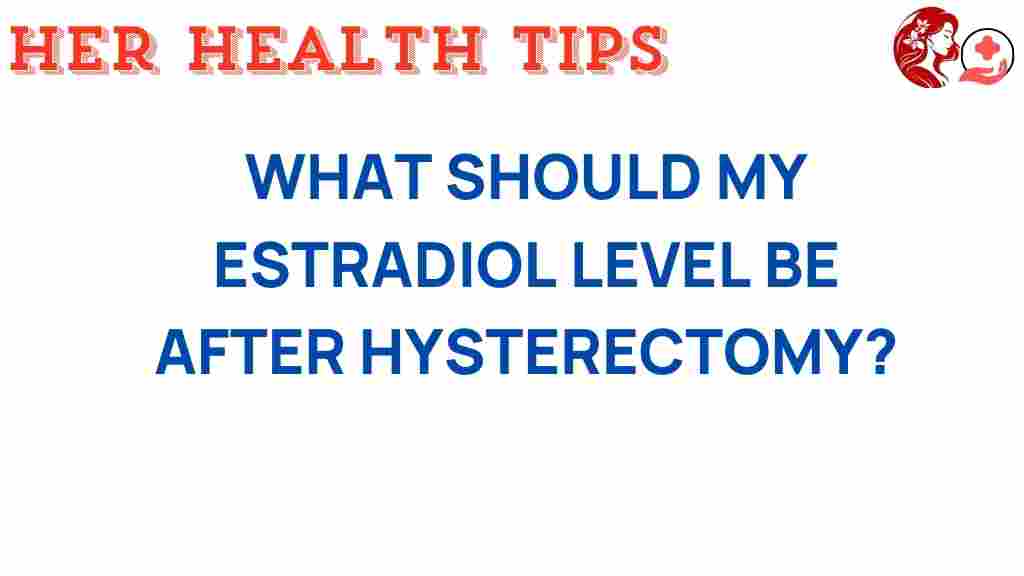Understanding Estradiol Levels Post-Hysterectomy: What You Need to Know
Hysterectomy is a significant surgical procedure that involves the removal of the uterus. For many women, this surgery is a necessary step toward improving their overall health, particularly when addressing conditions like fibroids, endometriosis, or cancer. However, one of the critical aspects that often gets overlooked is the impact of hysterectomy on hormone levels, especially estradiol. In this article, we will discuss estradiol, its importance in women’s health, and how to manage hormone levels effectively post-surgery.
What is Estradiol?
Estradiol is a form of estrogen, a primary female sex hormone that plays a vital role in various bodily functions, including:
- Regulating the menstrual cycle
- Maintaining bone density
- Supporting cardiovascular health
- Promoting healthy skin
- Influencing mood and cognitive function
After a hysterectomy, especially if the ovaries are also removed (a procedure known as oophorectomy), women may experience a significant decline in estradiol levels, leading to various symptoms and health issues.
How Hysterectomy Affects Estradiol Levels
During a hysterectomy, the uterus is removed, and if the ovaries are also removed, the body’s primary source of estradiol is eliminated. This sudden change can lead to:
- Hot flashes
- Night sweats
- Vaginal dryness
- Mood swings
- Fatigue
Understanding these changes is crucial for recovery and long-term health monitoring.
Post-Surgery Recovery and Estradiol Levels
Recovery after a hysterectomy varies from woman to woman, and how estradiol levels fluctuate can significantly impact this process. Here’s a step-by-step guide to managing your health post-surgery:
1. Monitoring Hormone Levels
After your hysterectomy, regular monitoring of your hormone levels is essential. Your healthcare provider may recommend:
- Blood tests to measure estradiol levels
- Regular check-ups to assess symptoms and overall health
It’s important to keep track of how your body is responding to the changes in hormone levels.
2. Discussing Estrogen Therapy
If your estradiol levels are significantly low post-surgery, your doctor might suggest estrogen therapy. This can help alleviate symptoms related to low estrogen levels. Types of estrogen therapy include:
- Oral medications
- Transdermal patches
- Topical gels or creams
Each option has its benefits and potential side effects, so a thorough discussion with your healthcare provider is essential.
3. Lifestyle Changes for Hormonal Balance
In addition to medical treatments, several lifestyle changes can support hormonal balance:
- Diet: Incorporate foods rich in phytoestrogens, such as soy products, flaxseeds, and whole grains.
- Exercise: Regular physical activity can help manage weight and improve mood.
- Stress Management: Techniques such as yoga, meditation, or deep-breathing exercises can help reduce stress levels.
Potential Challenges and Troubleshooting
While managing estradiol levels post-hysterectomy, some women may encounter challenges. Here are some common issues and tips for troubleshooting:
1. Persistent Symptoms
If you continue to experience symptoms like hot flashes or mood swings despite treatment, consider:
- Consulting with your healthcare provider about adjusting your estrogen therapy.
- Exploring other hormone replacement options, including progesterone.
2. Side Effects of Hormone Therapy
Some women may experience side effects from hormone therapy, such as:
- Nausea
- Headaches
- Breast tenderness
If you experience these side effects, discuss them with your healthcare provider. They may recommend adjusting the dosage or switching to a different form of therapy.
3. Emotional and Mental Health
Post-hysterectomy, some women may struggle with emotional and mental health issues due to hormonal changes. It’s vital to:
- Seek support from friends, family, or support groups.
- Consider speaking with a mental health professional if feelings of depression or anxiety persist.
Health Monitoring: The Key to Managing Estradiol Levels
Consistent health monitoring is essential for maintaining hormonal balance post-hysterectomy. Here’s how to keep track:
- Regular Check-Ups: Schedule follow-up appointments with your healthcare provider to monitor estradiol levels and overall health.
- Symptom Diary: Keep a diary of your symptoms, mood changes, and any side effects from treatments. This can help your doctor make informed decisions about your care.
- Blood Tests: Follow your healthcare provider’s recommendations for blood tests to assess your hormone levels.
Conclusion
Understanding estradiol levels post-hysterectomy is crucial for a successful recovery and maintaining overall health. By monitoring hormone levels, considering estrogen therapy, and making lifestyle changes, women can effectively manage their health post-surgery. Remember, every woman’s experience is unique, so it’s essential to work closely with your healthcare provider to develop a personalized plan that suits your needs.
For more information on women’s health and hormonal balance, visit WomensHealth.gov. If you are considering a hysterectomy or have questions about your recovery, talk to your healthcare provider for advice tailored to your situation.
This article is in the category Reproductive and created by HerHealthTips Team
